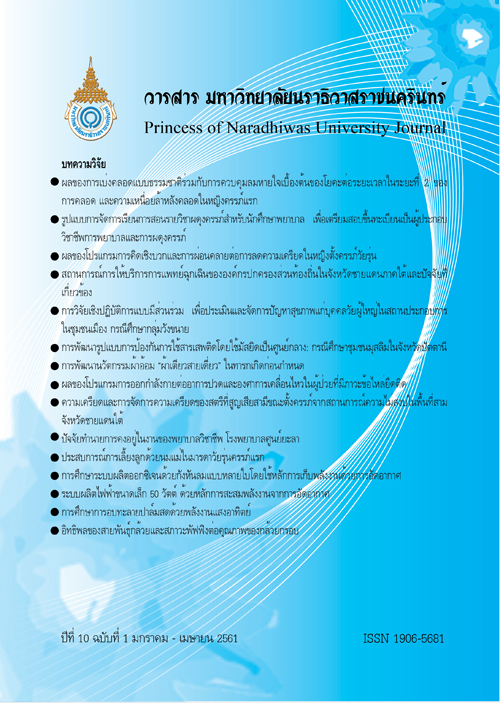Participatory Action Research on Health Evaluation and Health Problem Management for Adults in the Urban workplaces: A Case Study of Wangkanai Group
Keywords:
Participatory action research, Health problem management, Adult, urban workplacesAbstract
The objective of this research was to encourage the participation of health problem evaluation and
management for adults in the urban workplaces. The research tools comprised of the demographic record
forms, the diabetes risk assessment form in the next 12 years with the sensitivity of 76.50 % and the specificity
of 60.20 %, the health diaries, tape recorders, guideline questionnaires of heath behavior and health
assessment instruments, which were prepared and verified compliance by the public health center. The 20
employees of Wangkanai group with the risk of non-communicable disease were purposive sampling. The
research was conducted during November 2013 – January 2014. The process of research was composed
of 1) planning 2) acting 3) observing and 4) reflecting and re-planning. The researchers collected data
regarding research participants’ health data before starting the project, after joining the program for one
month respectively. After the participants were informed of the results of health changes at the end of the
month, the participants had visited a nutritionist, a fitness expert and the researchers to receive individual
feedbacks and to have an interview on the result of changing health status. Demographic data and health
status data before starting the project were analyzed using basic statistics. Health status data after joining
the program for one month were classified by individual and the qualitative data were analyzed by content
analysis.
The results of this study revealed that four-step participatory action research of participants starting
from the planning stage, participants were involved in the choice of how they performed, how they
evaluated their own practice, tools that helped in monitoring behavioral health behaviors including information
on exercise and eating from the experts. In acting stage, after perceiving their health status information,
participants inspired, identified goals, and made behavioral modification plan. Then participants modified
health behaviors under inspiration, goals, and cooperation plan among researchers, participants, and
experts enhancing individual context of practice leading to good trend of health documentary in one month.
Additionally, after one month, the participants were aware of the changes in health status, reflecting on
the barriers, supportive factors to improve the behavioral modification plan to be implemented in the next
phase to lead to success. The researchers suggested that the success of enhancement of participation of
health problem management, being contributed to the change of health behaviors, depends on the unique
personal plan and the participation willingness of the health owners. The participants should be provided
counseling and reflection to understand the various aspects of information.
References
Aekplakorn, W. (2011). The fourth national health examination survey, Thailand 2008-2009. Nonthaburi: The Graphico system.
Chen, S.F. & Lin, C.C. (2010). The predictors of adopting a health-promoting lifestyle among work site adults with pre-diabetes. Journal of Clinical Nursing, 19, 2713-2719.
Fisher, K., & Kridli, S.A. (2014). The role of motivation and self-efficacy on the practice of health promotion behaviors in the overweight and obese middle-aged American women. International Journal of Nursing Practice, 20(3), 327-335.
Hudthagosol, C. (2013). Eat a lot of sugar as a cause of aging. Retrieved April 7, 2015, from https://www.ns2.php.mahidol.ac.th/phklb/Detail/index/837.
Indrakamphaeng A. (2009). Behavior modification based on 3self concept with PROMISE Model Principles. Bangkok: Sukhumvit Printing Co., Ltd.
Institute for Population and Social Research, Mahidol University. (2012). Population of Thailand 2012 (Estimated on 1 July 2012). Mahidol Population Gazette, (21) January, 1.
Karoonngamphan, M., Suvaree, S., & Numfone, N. (2012). Health behaviors and health status of workers: A case study of workplaces in Sathorn district, Bangkok Metropolitan. Songklanagarind Journal of Nursing, 32(3), 51-64.
Kemmis, S., & McTaggart, R. (Eds.). (1988). The Action Research Planner. (3rd ed.). Geelong, Victoria: Deakin University Press.
Lauziere, T.A., Chevarie, N., Poirler, M., Utzschnelder A., and Belanger, M. (2013). Effects of an Interdisplinary
Education Program on Hypertension: A Pilot Study. Canadian Journal of Cardiovascular Nursing, 23(2), 12-19.
Piyanun, L., Nitaya, S., Ameporn, R.,& Dittakam, B. (2011). Effectiveness of a self-regulation program on diet
control, exercise, and two-hour postprandial blood glucose levels in Thais with gestational diabetes
mellitus. Pacific Rim International Journal of Nursing Research, 15(3), 173-186.
Rigsby, B.D. (2012). Hypertension Improvement through Healthy Lifestyle Modifications. The ABNF Journal, Spring, 22(2), 41-3.
Satcha, T., & Nakarit, K. (2012). The Development of Nursing Service System for Tuberculosis Patients in Ranong Hospital. Journal of Nursing Division, 39(2), 22-36.
Sinawat, S. (2009). Survey on sodium chloride consumption in Thai population. Nonthaburi: Bureau of Nutrition, Department of Health, Ministry of Public Health.
Teixeira, P.J., Partrick, H., & Mata, J. (2011). Why we eat what we eat: the role of autonomous motivation in eating behavior regulation. Nutrition Bulletin, 36(1), 102-107.
Venkataraman, K., Kannan, A.T., Kalra, O.P., Gambhir, J.K., Sharma, A.K., Sundaram, K.R., et al. (2012). Diabetes
Self-efficacy Strongly Influences Actual Control of Diabetes in Patients Attending a Tertiary Hospital in India. Journal of Community Health, 37(3), 653-662.
Wisetchoonhaslip, A., Sarakarn, W., Mayuret, W., & Jangajil, T. (2013). Developing Pattern the End of Life Cancer Patient Palliative Care Cooperated with Multi-disciplinary Team. Prapatumvoratchawongsa5, Nursing Service Task Department. Sappasittiprasong Hospital Ubonratchathani. Academic Conference Annual General Meeting: The Nurses’ Association of Thailand Northeastern Division on 2-3 August 2013. Ubonratchathani: Sunee Grand and Convention Center Hotel.




